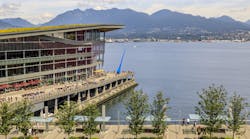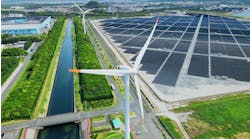Convention centers are important gathering places for community and business events. Many have implemented meaningful sustainability initiatives, leading by example in energy efficiency, resource conservation, and waste management. Below are several initiatives that commercial event venues can take to reduce their environmental impact.
1. Green purchasing
The best sustainability initiatives tweak daily habits to produce great results over time. Convention center operators have many opportunities to make eco-friendly buying decisions for their events, starting with these significant expenses:
- Food and beverages: Buying locally grown products reduces transportation costs and emissions. Providing vegetarian menu items also reduces emissions since the food products require less land and energy for production.
- Dinnerware: Buying compostable utensils instead of single-use paper and plastic dinnerware can reduce landfill waste. Cups and napkins made from recycled sources are also more common.
- Cleaning products: Chemical cleaning products with fewer volatile organic compounds improve the building’s air quality and the guest experience. Paper towels, toilet paper, and hand soap with U.S. Department of Agriculture (USDA) and Green Seal certifications are the new standards.
Convention centers can also purchase appliances that reduce the building’s energy load, such as LED fixtures, power strips, uninterruptible power supplies. Employees must remember to turn off technology when possible to maximize the sustainability benefits.
2. Food independence
Self-sufficiency is becoming a hallmark of commercial building design, especially in the hospitality industry. Convention centers, hotels, restaurants and catering companies are growing vertical farms to cut costs, ensure better food security, and incorporate biophilic design features. Here are a few examples:
- In 2017, the Greater Columbus Convention Center in Ohio started its Smart Farm, which produces between 2,000 and 3,000 pounds of kale, basil, mint, and other leafy greens yearly.
- In Florida, the Orlando World Center Marriott uses a farming technique called the HyCube next to the hotel’s central kitchen. The HyCube grows lettuce, herbs, and edible flowers for its catering menus.
- Nearby, the Orange County Convention Center boasts Center-to-Table Gardens in its west building. The space includes 81 towers with 44 planting pots.
Vertical farming is one part of a widespread transition toward “edible cities.” At the current rate of urbanization, nearly 70% of the global population will live in a city by 2050. That means urban centers must develop new farming methods within their communities to provide easy access for residents and prevent food scarcity. Convention centers and other high-traffic commercial buildings will be essential in edible cities.
Sustainable convention centers can also purchase eco-friendly food products from USDA, Fairtrade, the Global Animal Partnership and other environmental organizations that set high standards for ingredients, manufacturing, and working conditions.
3. Climate control
Climate control is a vital part of a sustainable convention center. As the building’s interior temperature fluctuates with weather and occupancy conditions, the HVAC system and other interior air quality conditioning tools must expend more energy to keep occupants comfortable. This dilemma is one of the most significant challenges in improving energy efficiency in commercial spaces.
Heat pump technology lets convention centers fully electrify their heating and cooling systems. In Toronto, the Enercare Centre at Exhibition Place has incorporated 11 heat pumps and slashed energy consumption by 38% in 2018.
More buildings are using green roofs or living roofs to limit temperature fluctuation and maintain climate control. These roofs have a waterproofing membrane, soil, and diverse vegetation that, with proper maintenance, can reduce air conditioning use by up to 75%. They also reduce air pollution, prevent water leaks, and improve the local biodiversity.
Regular maintenance of installed HVAC systems is vital to maintaining their efficiency. At minimum, air filters should be changed every 90 days and boilers must pass a hydrostatic test and an annual visual inspection, at the minimum. Climate control is equal parts maintenance and innovation.
4. Investing in solar energy
Sustainable convention centers are investing in solar panels to create their own clean electricity. Initial installation costs are steep, but many commercial buildings achieve a return on investment in just a few years.
In Salt Lake City, the Salt Palace Convention Center has implemented a unique strategy to get a total return on its solar panels. Organizations booking the center can participate in a Solar Renewable Energy Credits program, which offsets the event’s carbon footprint—while increasing the center’s revenue.
According to a 2022 survey by The Conference Board with The Harris Poll, 70% of Gen Z consumers say a business’s climate attitudes and initiatives heavily influence their buying decisions. This research suggests up-and-coming organizations are more likely to do business with convention centers that install solar panels.
Convention centers and commercial businesses also have generous government incentives for switching to solar energy. The 2022 Inflation Reduction Act includes a 30% tax credit for property owners that install operational solar panels before 2032.
5. Water conservation
Sustainable convention centers are diving into water recycling systems and harvesting devices that capture and purify rainwater. Green roofs can work with water-harvesting systems, multiplying the benefit.
The Vancouver Convention Centre provides an excellent template for a successful commercial water harvesting system. In 2008, the building started a wastewater recycling program that treats and reuses blackwater from toilets, sinks, and dishwashers for toilet flushing and irrigating its green roof. This initiative helped the VCC become the world’s first double-LEED Platinum building.
Convention centers can also conserve water in smaller ways, such as installing low-flow water fixtures with manual functions. Contrary to popular belief, automatic-flush toilets can consume 54% more water than regular toilets because they flush more often.
6. Recycling and waste management
Recycling programs are commonplace in commercial buildings, but sustainable convention centers are taking them to new heights. For example, the Pennsylvania Convention Center recycles cooking oil, light bulbs, and other miscellaneous items along with plastic bottles and aluminum cans.
Food waste is a critical issue for convention centers, hotels, and other businesses that go through tons of food. Instead of throwing it away, convention centers can donate it to local charities, repurpose the food for other dishes, or start a compost pile and add it to green roof soil.
The aforementioned Salt Palace Convention Center has partnered with local businesses and nonprofits, donating more than 500,000 pounds of event materials, such as scrap metal and wood, since 2017. The Raleigh Convention Center in North Carolina has donated almost 800 banquet meals to local charities. In Dallas, the Kay Bailey Hutchison Convention Center has donated 5,000 pounds of leftover food to local homeless shelters.
Sports venues participate as well. The Hard Rock Stadium in Miami donates leftover perishable food to its hourly employees.
Convention centers must also institute strict policies for certain nonrecyclable items, such as single-use plastic bags and plastic wrap. Keeping these items out of the building ensures they stay out of the recycling stream or compost piles.
Convention centers are prominent, revenue-generating destinations that host an array of industries, events, and individuals. As a result, they should lead by example and take their sustainability initiatives seriously, from energy conservation to waste management.
Emily Newton is editor-in-chief of Revolutionized.
For more news, projects, and profiles in the smart buildings ecosystem, subscribe to the SBT newsletter and follow us on LinkedIn, Twitter, and Facebook.



